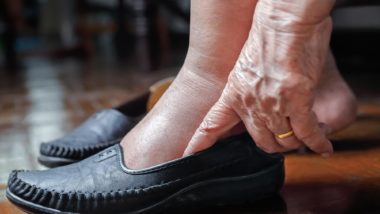Top Class Actions’s website and social media posts use affiliate links. If you make a purchase using such links, we may receive a commission, but it will not result in any additional charges to you. Please review our Affiliate Link Disclosure for more information.

What Are the General Risks for Amputation in Diabetics?
All patients who have been diagnosed with diabetes should be aware of the potential risk of having an amputation at some point in the future. Anyone with this condition is at risk for health-related problems, such as having to remove part or all of a foot or leg.
Why Are Diabetics at Higher Risk for Amputation?
The high blood sugar levels that are caused by diabetes can damage the blood vessels and the nerves in the body. This includes those that are located in the legs and feet. In the event that a patient’s nerves are damaged, they might not feel the symptoms or pain of infections and ulcers. This means the possibility of gangrene or serious infection is higher.
The only way that doctors can treat these infections when they become advanced is to amputate or remove the affected area. Taking good care of the feet and looking for problems can help to avoid the risk of amputation.
What Are Some of the Early Signs of Infection?
A patient who has been diagnosed with diabetes should check their feet every single day and look for changes, including:
- Different colors
- Redness
- Cracks
- Sores
- Blisters
- Cuts
- Thick Calluses
- White spots
If the feet are warmer or colder than usual, this is also an indication that something is wrong. Wearing protective shoes and avoiding smoking are other ways for patients with diabetes to avoid the risk of amputation. An endocrinologist or a podiatrist might need to be seen on a regular basis for those patients who have already been diagnosed with nerve damage.
Do Drugs Increase the Risk of Diabetic Amputation?
A recent study found that people taking certain sodium glucose cotransporter 2 inhibitors may be twice as likely to require a lower limb amputation as those people taking other forms of diabetic medication. SGLT-2 inhibitors include Farxiga, Invokana, Invokamet, and Jardiance.
According to WebMD, these medications work by assisting the body with disposing of extra sugar through urination. A 2017 warning from the Food and Drug Administration indicated that two major clinical trials had connected these kinds of drugs to an increased risk of leg and foot amputations.
In various studies, researchers have reportedly found more than a twofold higher risk for lower limb amputation as well as another condition known as diabetic ketoacidosis for those patients who are prescribed an SGLT-2 inhibitor versus other kinds of medication.
Although those studies found that there was no significant risk for serious urinary tract infection, acute pancreatitis, bone fracture or acute kidney injury, patients taking SGLT-2 inhibitors should be mindful of the possibility of developing amputation risks.
If you or someone you know has already had to undergo an amputation while taking these drugs, you could be eligible to pursue compensation with the help of an experienced attorney.
What is Life Like After an Amputation?
Any person who undergoes some form of amputation, especially their foot, will have to adjust their lifestyle as a result. It can be a shock to lose a limb or undergo any form of amputation, and plenty of people will not realize how much they relied on that body part until they have to adapt to life after the fact.
Understanding the potential risks of amputation and being prepared for what life looks like after that point is critical for anyone undergoing a discussion about amputation. Amputation surgery involves removing all or a portion of the foot with the common goal of leaving behind as much healthy blood vessel, nerve tissue, and bone as possible, according to Alberta Health. If any part of your foot remains, it is not uncommon to continue to experience pain in that area.
The foot or leg is likely to be swollen for a month or longer and it is the patient’s responsibility to keep up with the maintenance on the cast and to ensure the wound area is kept clean. The doctor who helped with the surgery and the relevant healthcare staff can provide information about how best to prepare for the cleaning and healing process.
Losing a foot or leg is especially difficult for those people who lived an active and healthy life beforehand. It becomes very important for a person in this situation to adjust their habits and to continue to learn how to be successful post-surgery. It can be hard for patients in this position, however, to know that their amputation risk was heightened by taking a medication.
If you or a loved one experienced diabetes amputation after taking Jardiance or Farxiga, you may have a legal claim and may be eligible to seek compensation from the drug maker for your medical and other expenses. Fill out the form on this page now to see if you qualify!
ATTORNEY ADVERTISING
Top Class Actions is a Proud Member of the American Bar Association
LEGAL INFORMATION IS NOT LEGAL ADVICE
Top Class Actions Legal Statement
©2008 – 2024 Top Class Actions® LLC
Various Trademarks held by their respective owners
This website is not intended for viewing or usage by European Union citizens.
Get Help – It’s Free
Join a Free Jardiance, Farxiga Diabetes Amputation Class Action Lawsuit Investigation
If you qualify, an attorney will contact you to discuss the details of your potential case at no charge to you.
If you took Invokana or Invokamet, you do not qualify for this investigation. Click here to join a separate class action lawsuit investigation.
PLEASE NOTE: If you want to participate in this investigation, it is imperative that you reply to the law firm if they call or email you. Failing to do so may result in you not getting signed up as a client or getting you dropped as a client.
E-mail any problems with this form to:
Questions@TopClassActions.com.
Oops! We could not locate your form.












